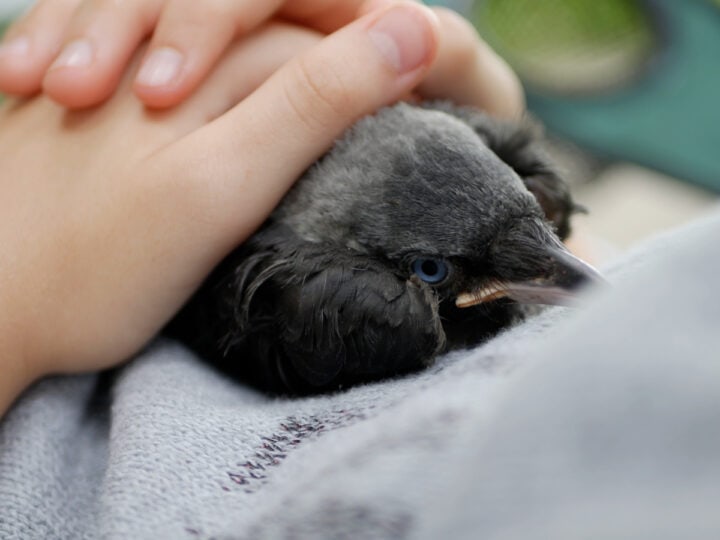Twice every year, some 500 million birds of at least 300 different species pass through Israel on their way to and from breeding grounds in Africa, Asia and Europe. Israeli ornithologists – there are dozens of them around the country – keep a running log of sightings on the Israeli Birding Portal.
In October, the blue-cheeked bee-eater made its first official appearance on that news feed in more than 50 years.
“All of a sudden, from out of nowhere, a flock of some 30-40 blue-cheeked bee-eaters appeared over the Yerucham Lake Park. There was no mistaking them as their colors and calls filled the air,” writes Eyal Shochat, academic manager at Hoopoe-Yerucham Center of Ecology and Ornithology, on the birding portal. “The blue-cheeked bee-eaters are rare spring migrants at Yerucham and this was the first time ever they showed up here in fall, quite a distance from their traditional migration route in the Jordan Valley.”
These colorful birds with bright green plumage happened to fly over Yerucham, a town in the Negev Desert, during a bird-ringing event. Shochat writes in his blog post that as soon as the ornithologists heard the songbirds’ cries, they played recordings of bee-eaters to attract them to the nets they had set up in order to tag other birds. They successfully caught and ringed six of these rare near-passerine birds.
“It seems their arrival was an announcement to us that the mystery of where they’d been all this time was about to be solved,” Shochat posted.
Among the bird-lovers was Nehama Baruch, a resident of Moshav Naveh in the western Negev, who took one look at these colorful songbirds with slender bodies and long beaks, and told the others that these were the same birds she had seen near her home in May 2012, digging a nest on a pile of earth. Baruch whipped out her smartphone and showed the surprised ornithologists all the photos she had taken three years prior.
Suddenly, the bird experts were able to make sense of previous sightings this past summer. KKL-JNF Chief Ornithologist Yaron Charka and Shochat had found a family of blue-cheeked bee-eaters near the Harari lookout over the Besor River in the northwestern Negev.
“Finding this species at this spot in summer, let alone with fresh fledglings, caught us by surprise, as the species breeding sites are known to be restricted to the Rift Valley,” Shochat posted on Hoopoe-Yerucham Center of Ecology and Ornithology’s Facebook page.
Surprise sightings
“We had to be careful with our conclusions, as blue-cheeked bee-eaters tend to gather together soon after breeding at sites that may be distant from their breeding sites.”
Meanwhile, Dominic Standing, a local birder and resident of Kibbutz Nirim, had reported seeing a large flock of some 130 birds around the Besor reservoir later in summer, long after the migration season.
Shochat explained in his blog post that these “surprise sightings” came just two months after the pallid scops owl had caught the Israeli birding community off guard about its population and whereabouts. “We found ourselves asking once again: How did such a large population manage to sneak under our radar, and for how many years?”
Baruch’s beautiful photos turned out to be the proof these bird experts needed to show that the species not only flies over the Negev but also nests there.

“The photos document the first time since the 1950s that a family of blue-cheeked bee-eaters has nested outside of the Jordan Valley,” writes Shochat, who also teaches at Ben-Gurion University of the Negev. “Nehama’s photos came to us in perfect timing with the arrival of the flock. It was the missing puzzle piece to the question of the whereabouts of these bee-eaters in Israel.”
Shochat says other sightings of this species, one of 26 of the bee-eater family, had been recorded over the years and ornithologists knew of small numbers nesting in the Jordan Valley area. Although these birds nest by making a tunnel in a sandy bank, they had not been recorded doing so in the Negev for a very long time.
“Having a second, large population in Israel is exciting news, as it will surely support the existence and conservation of this rare species internationally,” he writes, noting the need for a population estimate.
Shochat says about 25 kilometers south of the Harari lookout, where he first saw these birds, is an area with sandy-wall valleys, perfect for blue-cheeked bee-eaters to nest. In fact, the area has served for many decades as breeding sites of the common bee-eater.
“How many blue-cheeked bee-eaters nest in the Negev area? How do they share the land with their fellow common bee-eaters? And above all, will we be able to conserve their native breeding sites and enjoy their colors and unique calls in this heavily agriculturally developed area? The key to a green future lies in our hands,” Shochat says. “Time will tell.”















